Finding small black bugs in your house can be unnerving, especially if you don’t know what they are or how to get rid of them. That’s why it is essential to understand the different characteristics of common house pests and how you can eliminate them.
These are 6 most common types of small black bugs in the house:
- Ants
- Carpet Beetles
- Weevils
- Flour Beetles
- Pill Bugs
- Termites
This article will cover how to identify these insects based on size, where they live in your home and their essential characteristics. It will also give you some pro tips on how to get rid of these black bugs with some of the most effective pesticides and natural remedies.
Common Types of Little Black Bugs That Invade Our Homes
If you find an insect that you don’t recognize in your home, you might want to take a closer look at it. The likelihood is that it’s one of these prevalent indoor pests.
Some of the most common little black bugs that invade homes are ants, carpet beetles, weevils, flour beetles, pill bugs, and termites.
But what makes these bugs different, and how can you tell which one is invading your home? Let’s find out!
Ants

We all know that ants are one of the most common pests. They are scavengers that eat pet food, grains, crumbs, and anything else they can get their tiny hands on.
Ants have three pairs of legs and bodies with three segments: the abdomen, thorax, and head. They also have antennae that they use to smell food and detect movement in their environment.
While some ants may stray from their companions to find their way inside your home, most ants only travel and live in large colonies. When they find a reliable source of food, they lead the rest of the colony to the food so that they can bring it back to their queen, who lives beneath the ground in an anthill.
Related: How to Get Rid of Ants Naturally?
Carpet Beetles
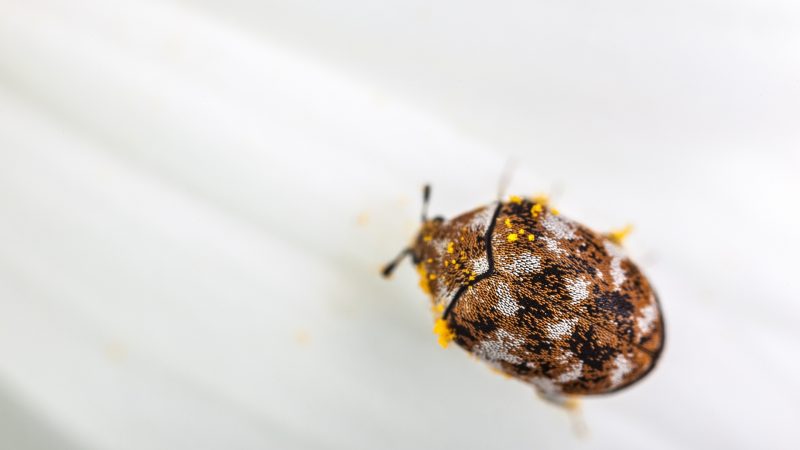
Carpet beetles are another of the most common insects that invade homes. They are round, have spherical bodies, and have wings. Their shells are hard and shiny.
Carpet beetle larvae eat natural fibers like feathers, hair, wool, silk, leather, and dead bugs, making human dwellings the perfect spots for carpet beetles to lay their eggs.
However, adult carpet beetles eat pollen and nectar, so they are most commonly brought into homes on fresh-cut flowers.
There are several varieties of carpet beetles common to human households. Among the most common is the furniture carpet beetle, which lives in and feeds on upholstered furniture.
Carpet beetles may be black or calico with gray, yellow, and black spots.
Weevils
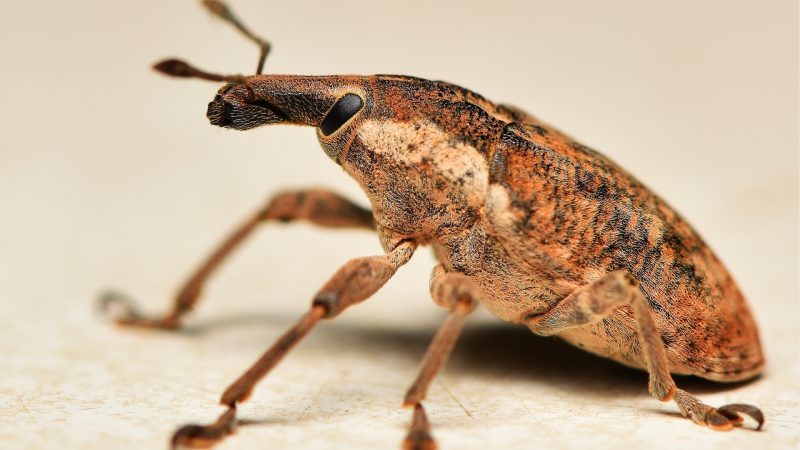
Weevils are common pantry pests that often enter homes inside food products like grains, cereals, pasta, pet food, and other dry foodstuffs.
They are oblong, narrow, and have long snouts. Their shells are hard and shiny with a vertical ribbed pattern and many little dot-like impressions. They also have antennae that bend at the midpoint.
Related: How To Get Rid of Rice Weevils?
Flour Beetles
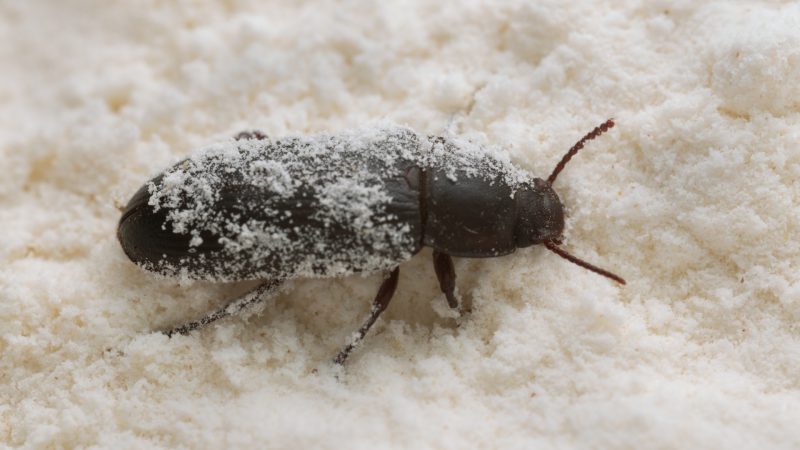
Flour beetles look much like weevils, and they feed on flour and other types of finely-ground grain products.
Additionally, flour beetles have oval-shaped, narrow bodies with black, dark brown, or reddish-brown shells. They have wings and wing pads that have a ribbed, vertical pattern. They also have clubbed antennae with three separate lobes on them.
Related: How To Get Rid of Black Beetle?
Pill Bugs
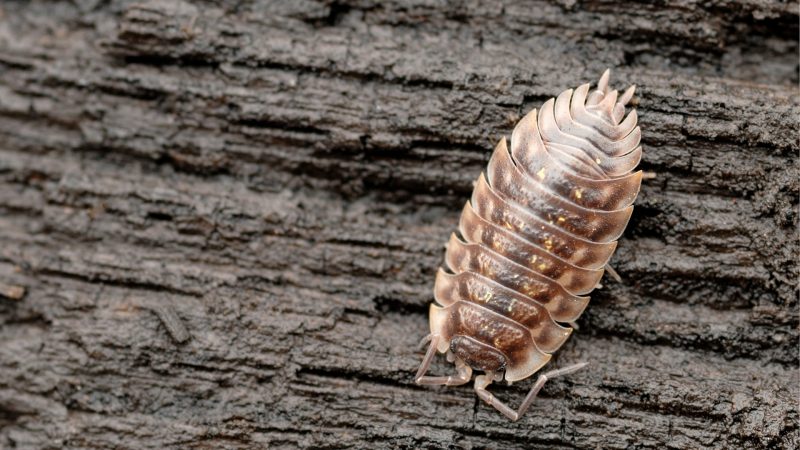
Pill bugs, also known as “roly-poly bugs” or woodlice, are common pests in potted plants and damp areas of your home.
Pill bugs have dark gray or dark brown bodies that often look black unless you look at them under a microscope. Pill bugs have round, segmented shells that resemble the outer armor of an armadillo. They also have two antennae that jut out at a 90-degree angle from the pill bug’s head.
They eat decaying plant matter, so they most commonly live in indoor plants, windowsills, and damp areas of your home.
Termites
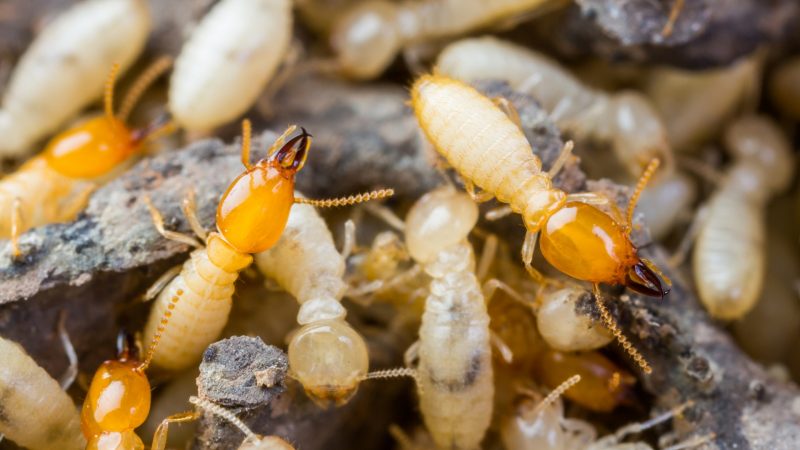
Termites are one of the most invasive indoor pests, and they usually appear in homes during the springtime when they swarm and look for a new place to start colonies. They eat wood. When termites detect an enormous surplus of wood, they bore holes into it and build underground tunnels to breed and lay eggs.
In every termite colony, there are a queen and many workers, reproducers, and soldiers. The workers, reproducers, and soldiers are the ones that you will see since the queen hardly ever leaves the colony.
Reproducer termites look like black ants with broad wings that fall off after finding a place to feed. However, unlike ants, these termites have very long, flat abdomens with a horizontal ribbing pattern and straight antennae.
Related: Termite Droppings: Differences Between Termite Poop and Sawdust
Identification of Small Bugs by Size
Here’s an Identification chart so you can determine what kind of pests you have by size:
| Small Bug | Size (in Length) |
| Ant | 1/16 to 1/2 inch (1.5 to 12 mm) |
| Carpet beetle | 1/16 to 1/8-inch (1.5 to 3.2 mm) |
| Weevil | 1/8th inch (3.2 mm) |
| Flour Beetle | 1/7 inch (3.6 mm) |
| Pill Bug | ⅓ to 7/10 inch (8.5 to 18 mm) |
| Termite | 1/4 inch (6.35 mm) |
Ants
Ants are usually anywhere between 1/16 to 1/2 inch (1.5 to 12 mm) long.
However, the most common house ant is the pavement ant, which is attracted to sweet foods. This ant is small, measuring 3/16 inches (4.76 mm) long.
Carpet Beetles
Carpet beetles are tiny beetles, usually measuring between 1/16 to 1/8-inch (1.5 to 3.2 mm) long. However, furniture carpet beetles are generally only 4/5 to 3/32 inches (2 to 3.5 mm long), making them extremely small.
Weevils
Weevils are 1/8th inch long (1.5 to 3.2 mm) and have a rounded abdomen. The cowpea weevil, frequently found on beans, isis around 1/4 inch long (2.5 to 5.4mm), while the rice weevil is slightly smaller at 3/16 of an inch (3 to 4.2 mm). The boll weevil, the scourge of cotton crops, is generally around 1/4 inch (6 mm).
Flour Beetles
Flour beetles are a bit larger and longer than weevils, measuring 1/7 inch (3.6 mm) long as mature adults. Flour beetle larvae, which look like tiny worms, are longer than their adult form, reaching as much as 1/4 inch (6 mm) before forming a pupa and re-emerging in a more compact form.
Pill Bugs
As adults, pill bugs are usually between 8.5 and 18 mm (0.34 to 0.71 in) long. Many of the larger pill bugs you see are actually sowbugs, a slightly larger related species. Sowbugs cannot roll up in a ball like pill bugs. Sowbugs also have two appendages protruding from their rear end, which pill bugs lack.
Termites
Reproducer termites, which are black and winged, measure 1/4 inch (6.35 mm), not including their large, detachable wings. A termite queen can grow over 4 inches (9 cm) long, dwarfing the worker and soldier subjects who care for the 30,000 eggs she lays each day.
Identification of Tiny Black Bugs by Specific Rooms That They Invade
You may be able to identify your pests based on where you find them. That’s because most insects will live near a food source, and each insect prefers a different kind of snack.
Based on the specific locations they prefer, you may find:
- Carpet beetles in bedrooms and linen closets
- Ants, flour beetles, and weevils in kitchens and pantries
- Termites in attics, crawlspaces, and basements
- Pill bugs in potted plants
Let’s talk more about why some bugs prefer to live in certain rooms in your home.
Bedrooms and Linen Closets: Carpet Beetles

Since carpet beetles eat textiles, they are common pests in bedrooms with wool, linen, silk, or feather items. Carpet beetles can also eat mattresses and down pillows from the inside out.
Carpet beetles often go undetected until they do noticeable damage to your textiles since they are so small. It is common to find carpet beetle exoskeletons beneath mattresses and other furniture, even before seeing a live beetle.
Kitchens and Pantries: Weevils, Flour Beetles, and Ants
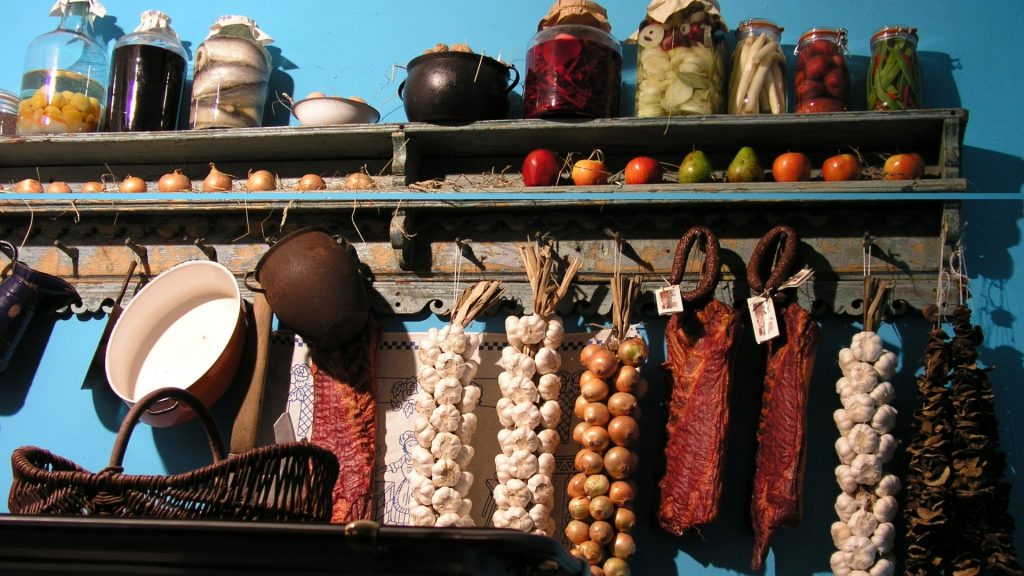
Weevils, flour beetles, and ants all eat human food, making them common pests of pantries and kitchens.
Often weevils and flour beetles enter your home via food products since they are common food-factory pests.
Ants, however, enter homes from tiny crevices in walls, doors, and windows. Carpenter ants can eat through wood, creating a point of entry for other ants.
Related: How to Get Rid of Ants in Walls?
Basements, Crawlspaces, and Attics: Termites

Termites most often enter homes through wooden construction materials like floorboards, foundations, door frames, window frames, and more.
When termites are swarming, they are attracted to daylight. So, during the day, termites will leave their wooden homes and seek out the nearest window.
Near Potted Plants: Pill bugs

Pill bugs eat dead plant matter and keep your potted plant’s soil clean. So, you will likely find them living near potted plants in damp areas of your home.
However, if their population gets out of control, you may need to remove them from your home.
Identification of Little Black Bugs Based on Their Specific Traits
Identifying the type of insect that is invading your home can be a challenge, but that’s why this article is written to help. Let’s identify these common black bugs based on their shell hardness, body shape, wings, antennae, and some of their unique characteristics.
For easy identification, take a look at this simple chart:
| Bug Type | Hard Shell | Body Shape | Wings | Antennae | Unique Characteristics |
| Ants | No shell | Three segments | Only winged ants have wings | Bent antennae | Often come in large groups |
| Carpet Beetles | Has hard shell | Round like a ladybug | Has wings | Clubbed antennae | Has hairy, large larvae |
| Weevils | Has hard shell | Oblong | Clubbed antennae | Long snout | |
| Flour Beetle | Has hard Shell | Oblong | Has wings | Clubbed antennae | Downward-curving antennae |
| Pill Bug | Has hard, plated shell | Oblong | No wings | Antennae that curve out at a 90° angle | Can roll up into a small sphere |
| Termite | No shell | Three segments | Four wings of equal size that fall off | Straight antennae | Can shed wings. Younger termites are yellowish-brown. |
Best Insecticides for Getting Rid of Small Black Bugs

If you want a product that does it all, check out these spectacular insecticides from Amazon. They work against a broad spectrum of insects, so they will always be helpful to keep around:
Best Overall: Diatomaceous Earth DE10
This diatomaceous earth is essential for fighting almost any insect, so you might want to keep a bag in your home. It’s food-grade, organic, and ethically sourced, so it’s safe enough to use in your vegetable garden, kitchen, bedroom, and even around your children and pets. It’s effective against thousands of insects, including all of the little black bugs on this list.
- OMRI Listed - Listed with the Organic Minerals Research...
- Natural Product - Composed of 10lbs of 100% ground freshwater...
- Vegan-Keto-Gluten Free
- Diatomaceous Earth is a natural source of freshwater amorphous...
Best for Infestations: Ortho Home Defense MAX
This powerful insecticide spray is excellent for indoor applications and lasts for months, making it perfect for large infestations. It also makes a fantastic preventative spray to treat the perimeter of your house, beneath furniture, and behind appliances in your kitchen.
- Ortho Home Defense Max Indoor Insect Barrier kills and prevents...
- KILL LISTED INSECTS FAST: Kills all common household bugs like...
- INDOOR USE: Apply wherever insects are: in kitchens, bathrooms,...
- USE WITH CONFIDENCE: Dries up to 30% faster (vs. other Ortho...
- EASY TO APPLY: Extended Reach Comfort Wand, now with 2X the reach...
Best for Problem-spots: Harris Asian Lady Beetle and Box Elder Killer
This excellent, long-lasting spray is safe for kids and pets after it dries, so you can use it anywhere where bugs seem to gather to kill them for up to 3 months with just one application.
- Kills Lady Beetles When Spray Dries - The spray will kill once...
- Odorless Formula - Odorless and non-staining formula will not...
- EPA Registered - Registered with the Environmental Protection...
- Ready to Use - Ready to use formula requires no mixing or shaking
- Water Based - Water based formula leaves behind absolutely no...
Related: Diatomaceous Earth Uses as a Natural Pesticide
How To Get Rid of Small Black Bugs | Control Guide
Getting rid of bugs may seem impossible at first, especially if you have a large-scale infestation, but don’t fret. There is always a way to eliminate pests if you take the proper steps.
To get rid of your little black bugs:
- Using a vacuum to suck up bugs, eggs, and larvae. This is one of the most effective ways to kill insects in your home. In addition, vacuuming well will eliminate crumbs and food debris that many insects eat, which will help you starve the bugs out.
- Treat the perimeter of your house with insecticide. Using a powder insecticide like diatomaceous earth or a spray like Ortho Home Defense will keep bugs from coming back into your home. Follow the instructions on your insecticide and regularly reapply to keep infestations from happening in the first place.
- Keep your lawn, garden, or outdoor areas clear of debris. Most small black bugs like to lay their eggs or hide in leaf piles, woodpiles, dense weeds, or tall grass. Keeping these things clean and away from your home will help discourage bugs from setting up camp outside your home.
- Repair any cracks or holes in foundations, doors, windows, and walls. Bugs usually get in through tiny crevices, and sometimes, the bugs can eat their way into your home, which is typically the case with termites and ants. Sealing cracks with caulk and repairing window screens usually do the trick to keep these pests out.
Keeping black bugs out of your home is much easier if you know what kind of pest you are dealing with. If you want to keep these insects out of your home, you can use insecticides and keep your house and yard as clean as possible to discourage insects from inviting themselves inside your house.
List of Sources
Waldvogel, M., Alder, P. (2017). Termites – Biology and Control. NC State Extension Publications.
Calvin, D. (2017). Confused Flour Beetle and Red Flour Beetle. Penn State Extension.
Merchant, M., et al. (2018). Flour Beetles. Texas A&M Entomology Extension.
Choe, D. H. (2020). Carpet Beetle Management Guidelines. University of California Agriculture and Natural Resources.
Gahlhoff, J. E., Jr. (2013). Furniture carpet beetle – Anthrenus flavipes. University of Florida Entomology Department.
- How to Get Rid of Copperheads | Practical Guide - August 27, 2023
- How to Get Rid of Corn Snakes | What Makes Them Aggressive? - August 27, 2023
- How to Get Rid of Alligators | Safety Measures and Removal Methods - July 16, 2023




